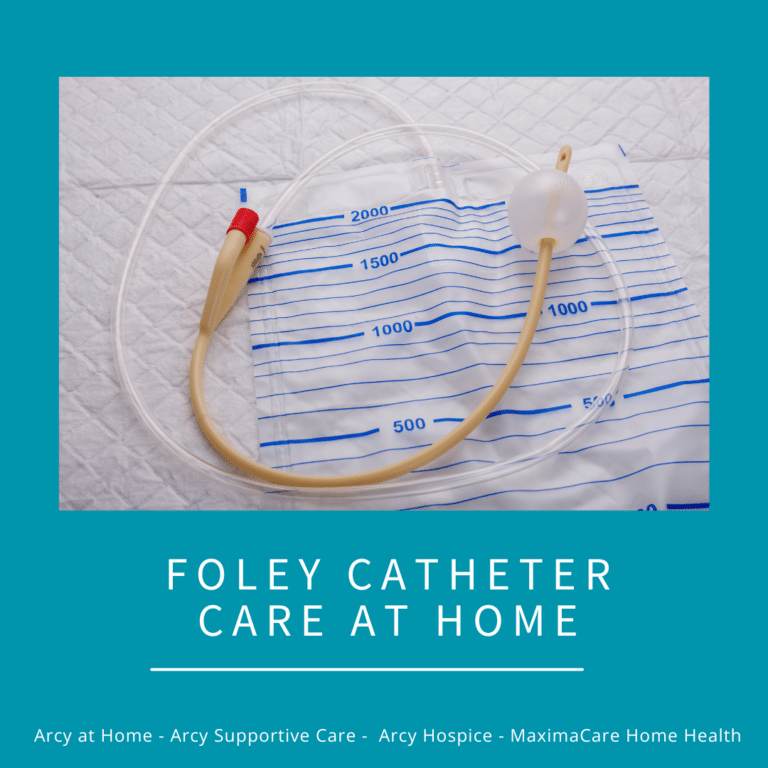Providing Foley catheter care at home can seem daunting, but with the right information and support, it can be managed effectively. Our team has put together a list of guidelines to help you care for a Foley catheter at home that can help reduce the risk of complications.
Important Advisory Information: Consult with your medical professional for personalized guidelines and instructions tailored to your specific situation. The following caregiving tips provide general insights, but always prioritize and adhere to your medical professional’s specific advice for optimal care.
What is a Foley Catheter?
A Foley catheter is a flexible tube inserted into the bladder to drain urine. It’s commonly used for individuals who have difficulty passing urine due to medical conditions, surgeries, or injuries.
When is a Foley Catheter Used?
Foley catheters are used in various scenarios, such as:
- To drain urine when there is an obstruction in the urethra, such as scarring or prostate enlargement.
- To aid urination in individuals with bladder weakness or nerve damage affecting their ability to urinate.
- To manage urinary function during and after surgical procedures.
How Can I Care for a Foley Catheter at Home?
Proper Foley catheter care at home is crucial to prevent infections and ensure the catheter functions correctly. Here are ten essential tips for effective catheter care:
- Consult with Caregiver: Consult with your medical professional for personalized guidelines and instructions tailored to your specific situation. The following caregiving tips provide general insights, but always prioritize and adhere to your medical professional’s specific advice for optimal care.
- Wash Your Hands: Always wash your hands thoroughly with soap and water before and after handling the catheter.
- Clean the Catheter: Clean the catheter tube at least twice a day with soapy water and a wet paper towel or washcloth. Gently pat the tube dry afterward.
- Empty the Collection Bag Regularly: Empty the collection bag every two to three hours if it’s small, or every eight hours for larger bags.
- Emptying the Bag: Begin by washing your hands thoroughly. Next, remove the stopper or open the clamp on the collection bag, and empty its contents into a toilet. If you need to measure urine output, use the container provided by your healthcare provider. Clean the drainage port with soap and water, wiping away from the port to push germs away. Afterward, pat the port dry and replace the stopper or clamp. Finally, wash your hands again.
- Change the Bag: To begin, wash your hands thoroughly. Then, empty the current collection bag. Clean the connection between the catheter and the bag using soap and water. Pinch the catheter tubing just above the connection point. Next, disconnect the old bag and attach the new one. Finally, release the tubing and wash your hands again.
- Avoid Kinks: Ensure there are no kinks or twists in the catheter tubing to prevent urine from backing up into the bladder.
- Secure the Catheter: Use securement devices or medical tape to keep the catheter in place and prevent tugging or displacement.
- Stay Hydrated: Encourage your loved one to drink plenty of fluids unless otherwise advised by a healthcare provider, as this helps keep urine flowing and reduces the risk of infections.
- Monitor for Signs of Infection: Watch for signs of urinary tract infections (UTIs), such as fever, chills, cloudy urine, foul-smelling urine, or pain around the catheter site.
- Follow Medical Advice: Always follow the specific instructions and guidelines provided by your healthcare provider regarding catheter care.
Potential Problems with Foley Catheters
While Foley catheters are essential medical devices, they come with potential risks, primarily infections. A very common complication is Catheter-Associated Urinary Tract Infections (CAUTIs). These infections can lead to serious health issues and often require medical treatment. It’s crucial to maintain stringent hygiene practices and monitor for any signs of infection to mitigate these risks.
By following these guidelines and knowing when to seek professional help, you can ensure that your loved one receives the best possible Foley catheter care at home, enhancing their comfort and well-being.
Contact our team to learn more about all of our home care services at 469-293-1515 or subscribe to our newsletter.
My name is Jimmie Stapleton. I am the founder and CEO of Arcy Healthcare. Arcy Healthcare includes Arcy Hospice, Arcy Supportive Care, Arcy Home Health and Arcy at Home.
Arcy Hospice was opened in 2007 to provide care and support for individuals and families facing a life limiting illness. It was established after my wife Ellen, who had been diagnosed with breast cancer, had completed her chemo and radiation therapies. At that time, things were looking positive, and we wanted to do something for our community that had been so supportive of our family during her treatments. Unfortunately, the cancer returned a few years later, and she subsequently passed away under our care in 2010.
In the years that followed, I began to see the need to provide the same level of excellent care to patients across the continuum of care. Therefore, we have added a home health division (Arcy Home Health), a palliative care division (Arcy Supportive Care), and a home care division, (Arcy at Home). With the addition of these divisions, we can meet most of the post-acute care needs for you and your family in your home.
I started Arcy Hospice with my wife as my motivation to provide exceptional care and support in the patient’s home, where they are surrounded by family and where they feel most comfortable. I’m proud to say that our staff provides some of the best in home care in the Dallas-Ft. Worth area.
Please let us know if we can enrich the quality of life for you or a loved one.
Sincerely,
Jimmie Stapleton – Founder and CEO
Arcy Healthcare
- Understanding the Connection Between Sleep and Balance - May 21, 2025
- Arcy Proudly Supports the TWU Meyers Stroke Center - May 19, 2025
- Making Nutrition Work for Seniors with Alzheimer’s Disease - May 8, 2025




